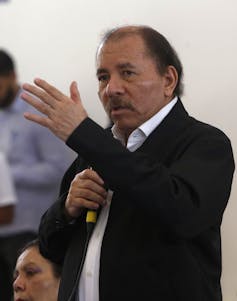
After months of near-constant protest in Nicaragua, at least 215 people are dead, 1,000 are injured, and President Daniel Ortega – an authoritarian leader who once seemed invincible – is on his last legs.
Citizens first took to the streets of Managua in early April after Ortega’s government was slow to respond to a massive forest fire inside Indio Maiz, the nation’s second-largest nature reserve. When the government quietly decided to tax retirees’ pension checks and increase employers’ insurance costs a week later, nationwide marches gained steam.
Police soon began killing protesters. What started as targeted, loosely organized protests quickly transformed into a movement. The goal: to remove President Daniel Ortega and his family from power.
Nicaragua vs. Goliath
Can Nicaragua, Latin America’s second poorest country, bring down its mighty regime by simply refusing to leave the streets? Local history suggests it can.
I am a Latin American scholar currently based in Managua, Nicaragua. My research on the ground suggests that presidents in this region who are challenged by mass protests fall much more frequently than one might suspect.
Most elected leaders in Latin America, a heavily democratic region, finish their terms. According to Christopher Martinez, a political science professor at Chile’s Temuco Catholic University, just 16 percent of South American presidents have resigned or been impeached since 1979.
However, that changes when leaders earn the ire of their citizens. Between 1985 and 2011, fully 70 percent of South American leaders who faced mass street protests were ultimately removed from office.
Nicaraguan protesters face a genuine Goliath in Daniel Ortega. In the only country since Cuba to orchestrate a successful armed revolution in Latin America, Ortega – a former Sandinista guerrilla who helped Nicaragua oust dictator Anastasio Somoza in 1979 – is a giant.
Ortega has been the most powerful person in Nicaragua for nearly 40 years and president for 16 of them. While out of office, from 1990 to 2006, Ortega effectively controlled the country as a powerful Sandinista delegate in the National Assembly.
Even when the Sandinistas were in the minority, Ortega could still bring the country to a halt by organizing mass protests, as he did countless times between 1990 and 2006. This irony is surely not lost on today’s anti-Ortega protesters.
But, as author Malcolm Gladwell writes in his latest book “David and Goliath: Underdogs, Misfits, and the Art of Battling Giants,” “Giants are not what we think they are. The same qualities that appear to give them strength are often the source of great weakness.”
In other words, dictators are not toppled, they trip over their own feet. In Ortega’s case, his greatest strength – his sheer audacity – has now fostered dangerous complacency.
How to topple a dictator
Latin America scholar Kathryn Hochstetler offers a basic formula for predicting whether Latin American presidents will fall to mass protest.

If street protesters have the support of the legislature but there is no bloody crackdown, she says, a president’s odds of surviving are high. That’s how former Nicaraguan president Enrique Bolaños, who governed Nicaragua from 2002 to 2007, managed to stay in office despite protesters’ calls for his resignation.
When leaders opt to use force against peaceful protesters, it seems, they enter a dangerous path. Since the early 1990s, almost every Latin American president who came to power in a free and fair election but later used violence to quell street uprisings was soon ousted.
The exception is in Venezuela. President Hugo Chávez went on to rule for 11 years after using deadly force against protesters during a 2002 coup attempt.
His successor, Nicolas Maduro, has remained in office despite killing 163 protesters in 2017, though I would argue that by the time Maduro came to power Venezuela was no longer a true democracy.
Dictators, ¡que se vayan!
In a region with a history of violent dictators, state repression sparks citizens’ anger.
Nicaragua has seen major political conflict. The Sandinista rebels staged a seven-year insurrection in 1979 to free the country from military rule. An 11-year civil war between the Sandinista government and U.S.-backed Contras followed.
At this point, there’s clearly little tolerance for more bloodshed. Protesters’ resolve is likely hardened by the fact that most of the dead are young students.
Isolated by decades of power, Ortega seems to have underestimated the degree to which state violence and repression would bring together factions that he had so adeptly divided for so long. Today, students, human rights groups, the business sector and the Catholic Church are united behind the goal of removing the president from office.
The military has publicly said that it will not leave the barracks to repress citizens. If the generals stick to their word, I believe Ortega’s days are numbered.
A fast fall from grace
Ortega’s fall from grace has come remarkably fast.
At the 27th anniversary of the Sandinista Revolution in 2006, Ortega rode a white horse into frenzied crowds on the Plaza de La Paz in downtown Managua. Later that year he would be narrowly re-elected as Nicaragua’s president.
In the years to follow, the government began placing massive billboards and posters featuring Ortega’s image around the country. The president centralized power in the executive branch, took control of Nicaragua’s National Assembly and Supreme Court, abolished term limits, and in 2017, appointed his wife as Nicaragua’s vice president.
Ortega was re-elected in 2016 for his third term with 72 percent of the vote. But only 30 percent of Nicaragua’s population voted in that year’s presidential election, and opposition parties alleged fraud.
![]() Perhaps his legitimacy was already in question back then. Now, Ortega’s demise seems as inevitable as his rise to power once did.
Perhaps his legitimacy was already in question back then. Now, Ortega’s demise seems as inevitable as his rise to power once did.
Benjamin Waddell, Assistant Professor of International Studies, Centro de Investigación y Docencia Económicas. This article was originally published on The Conversation.

